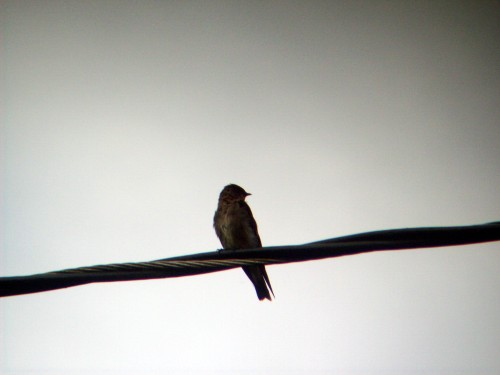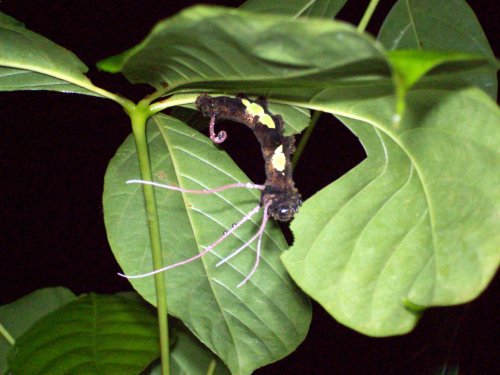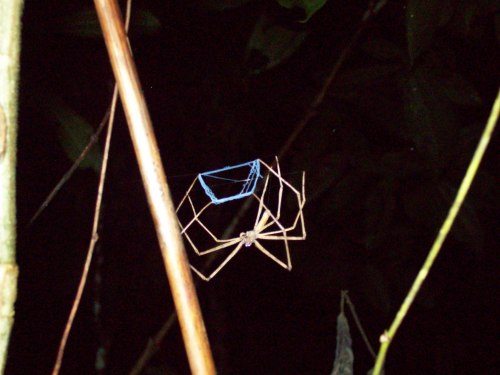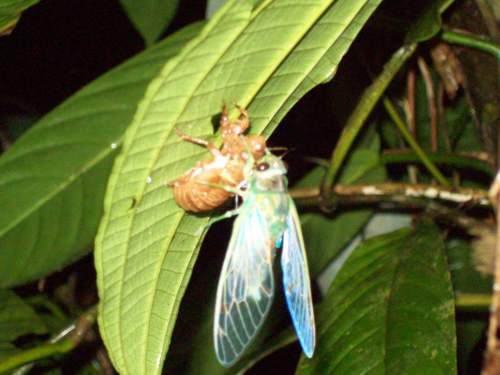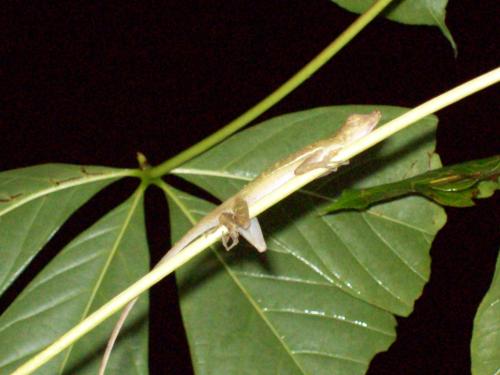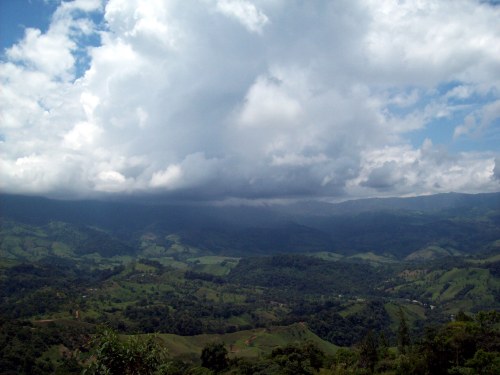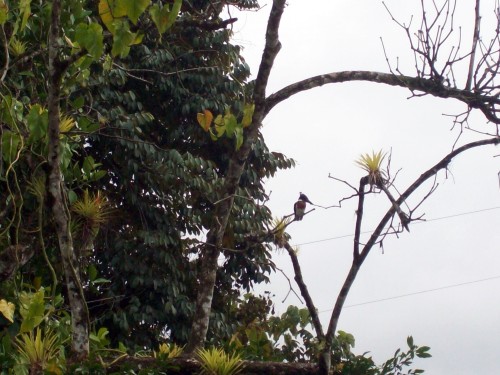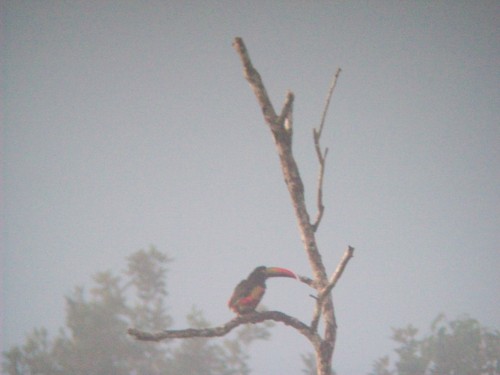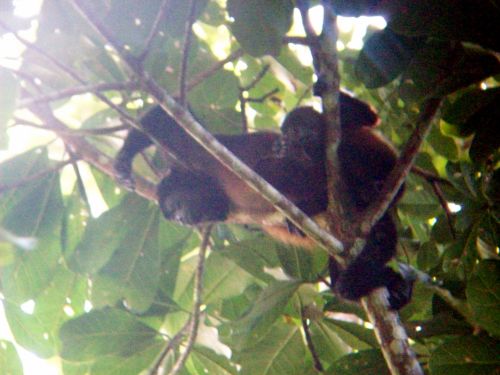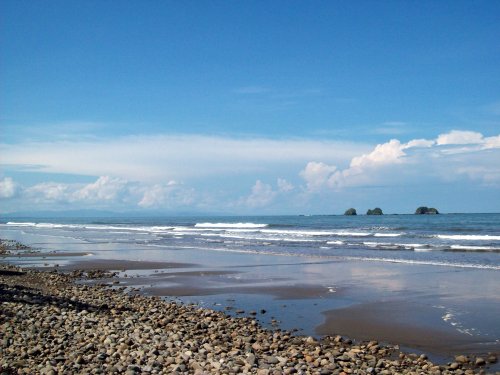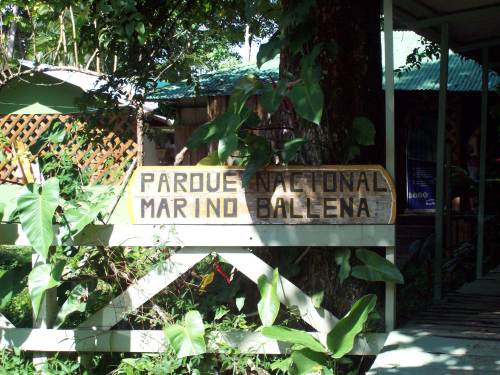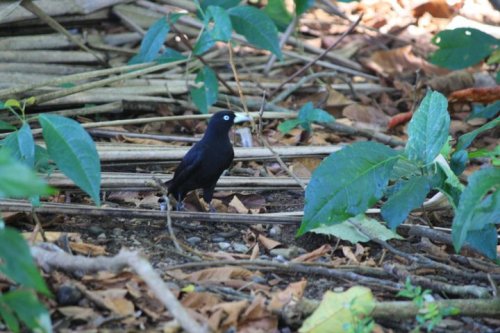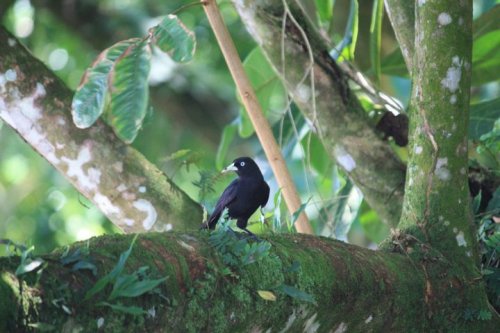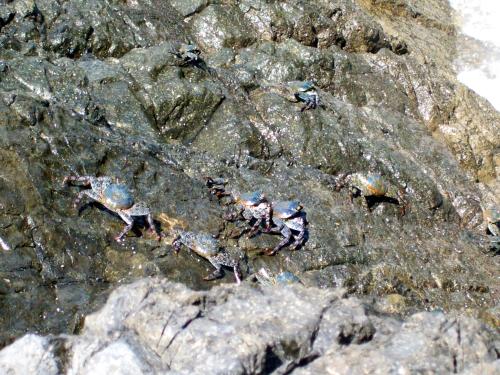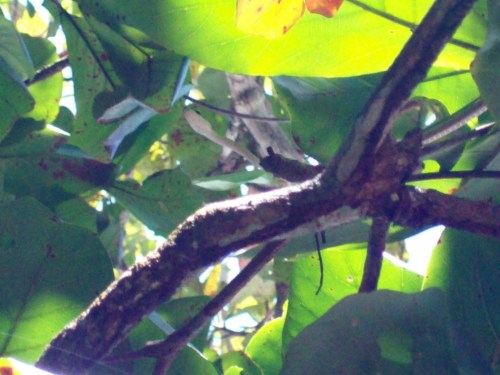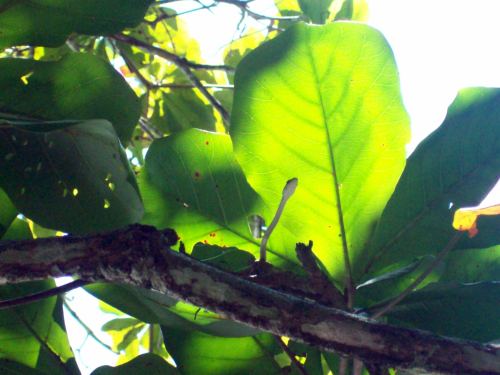I wake up to do some birding. We see a Palm Tanager, who can be identified by his tanager shape and posture, but he is rather plain colored for these exuberant and enigmatic birds. We also spot a Golden-hooded Tanager. This bird is exceedingly beautiful with its rich blue body and bright yellow cap and throat patch. We only see him at some distance, so his colors are not as easily visible as they could be, but just the sight of this bird reminds me why it is worth it to come out here in the mornings.

Golden-hooded Tanager
Greg is badly ill with terrible stomach cramps and a fever. Courtney and Katelyn are in a similar situation. I hope it will pass soon.
After breakfast, we head up to Milton’s saw mill. In doing so, we passed over a thin suspension bridge dangling about thirty feet above the river. It is only just wide enough to let us through. The cables creak as we get on and the bridge itself wobbles, buckles and shakes. Only one car can pass at a time. And to think that this bridge supports cattle laden trucks!
The mill is a fascinating operation. Milton, the owner, is a nimble, quick-moving fellow. I notice that he is doing his work in sandals. He built many of the machines in the mill by hand, including the sugar cane press. His mill primarily produces lumber to be used for homes and furniture.
We set off to work in the nearby field, protecting a natural spring from erosion by planting one hundred threes around it. Hopefully, the roots will arrest the soil and prevent the spring from being filled. I chop grass with my machete, Allison follows me digging holes, and Kate plants the trees. The sun beats down upon us with no respite.
About half an hour into the work, Jeff shouts that he sees a terciopelo, a fer-de-lance, and that it was headed towards Sarah. Oscar quickly dispatches the serpent with his machete. This may seem cruel, but ecologically, killing this snake will not matter, and it is certainly safer than having a venomous viper slithering around the workers, who have little experience with snakes. I notice that from this point on, my grip on my machete tightens and my concentration increases. This increases my terciopelo count to two, as yesterday, I saw one grappling with a frog. It is surprising that he went for prey so much larger than himself, as venom is difficult for the snake to produce and the frog seemed to have escaped unscathed.

Terciopelo (Fer de lance) grappling with a frog
After two hours, we finish our planting. Back at the saw mill, Milton agrees to show us the process by which sugar cane is turned into brown sugar bricks. First, the sugar cane is crushed by pushing it through a grinder consisting of two rotating drums, one atop the other. This creates a pulpy, green juice. The juice is then put through at strainer to remove any particulates and then poured into the concave top of a giant kiln. After two hours of boiling,most of the water is evaporated, leaving a thick liquid, which is then poured into molds and let dry to a solid. The sugar is very sweet from beginning to end. We sucked on the cane, drank the juice, and sampled the finished product.
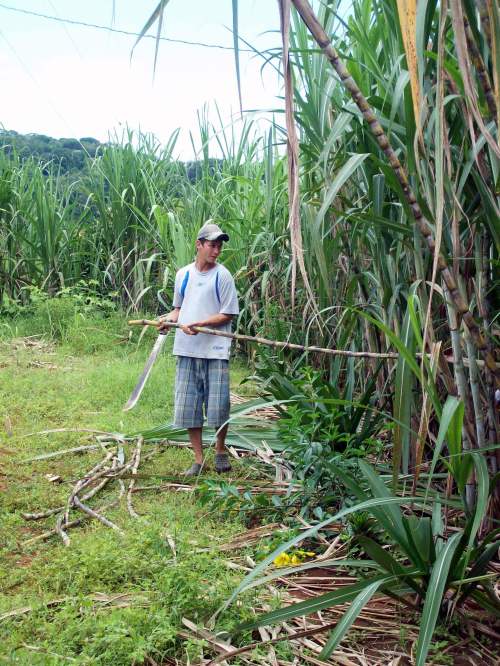
Gathering sugar cane
Back after lunch, I set out for a hike. I walk to about 200 meters, where I stop to watch a small lizard on a branch a few meters away from me. Then, in a flash, a large, dark shape enters my field of vision. It is a Double-toothed Kite. The large bird of prey grabs the lizard and flies further away to enjoy its meal. I am amazed by both the power and grace of this bird. I am also glad that I am too big to be considered a target for this hunter.
Further up, I see some poison dart frogs. I also note a bird nest at the end of a heliconia leaf. The nest is an inch wide and four inches deep. Unfortunately, before seeing the parent, I scare the mystery bird away. I do notice that there is a dime-sized white egg inside the nest.

Unknown (the owner shall be revealed in the next post) nest.
Pleased with myself, I head back down in order to go to church. I try to run there, but my shoulder still hurts too much as a result of the chopping. On the way there, I see a tree filled with vultures. I wonder what died nearby. Before mass, everyone gathers in front of the church to talk. In this way, the church serves both a religious and social function. The priest comes to Tres Piedras every two weeks. The church is small, barely the size of a classroom back home. It is also decorated very plainly with cloths and a sign with states that, “Your word, Lord, is my word and my salvation.” A tinny electric guitar supplies the music while a group of four women sings out of tune. The lack of formality (I am there in muddy clothes and bare feet) adds to the experience. Everyone is happy to be there. They clap during the songs and always respond with a gusto that is lacking in churches in the United States. We simply mumble the words in responses in order not to be “embarrassed.” There are no formal readers or long, wordy sermons. It is pure, sweet, and simple. I think that this is the way that mass should be done: children laughing and playing in the pews, a priest who laughs and smiles with his parishioners, and a church without gold. Despite the relative poverty of the area, people still give money during collection and dress in their best clothes. The gospel is that of the parable of the sower, who sows seeds on poor soil, thorns, rocks, and finally, fertile soil, the only place where they grow and produce yields. I cannot understand everything but my experience allows me to more or less follow along. The sign of peace is a particularly wonderful part of the mass here. Instead of simply nodding coolly to their neighbors without showing our emotions or, for that matter, our true self, the Ticos and Ticas get up out of the pews and address everyone with a hearty handshake, a hug, or a kiss. They smile and say “Peace be with you,” with great enthusiasm. Back in the US, this would be considered chaotic, but here, it is the only way things are, and in my mind, the way they should be.
We leave soon afterward so that we can attend lecture. The lecture is about Indigenous people. Elise, Ricardo , Sarah, and I have a big discussion about indigenous people and their ability/need to exploit the natural resources for resources. Elise has the opinion that they would not, given the chance and means, exploit the natural resources. Ricardo and Sarah said that they would, citing examples like Bronze Age Europe, the Easter Islanders, and the Aztecs. They think that it is simply a matter of human nature that they will do anything it takes to improve efficiency to survive. My own opinion lies somewhere in between the two. Part of me says that responsibility, self-restraint, and tradition would certainly prevent, to some extent, complete destruction of the resources, but history usually points in the other direction. We also discuss cultural relativism. Cultural relativism entails that your view of other cultures through the lens of your own culture, and because of this, you can never truly understand the other one. Thus, you should not judge them. However, most of us came to an agreement that some things are simply wrong on any and ethical or moral scale.
We go back to the cabin and check on the tarantula. Yesterday, we gave it a sacrifice of two cicadas. We capture no bugs except for cicadas. They are particularly annoying because they will sit on the wall for hours, buzzing loudly as if they were electrically charged, preventing any sleep. Also, they are the only insect that has a habit of flying into your face if you walk nearby, which is not only annoying, but also unsettling, as they are large bugs. Thus, we trap them under a cup while they rest on our wall and then place the cup over the hole where are tarantula lives. Then, during the night, the “Rancor” takes his meal. It has worked twice in the past two nights. After this, I promptly crash in bed.
Read Full Post »
